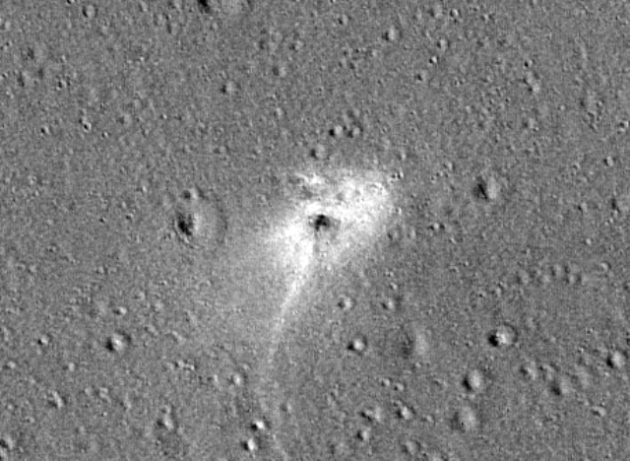NASA’s lunar orbiter spots the smoking hole left behind by Israel’s moon lander

The Israeli-built Beresheet moon lander made history when it went into lunar orbit and descended to the surface — and although it didn’t survive its crash landing, it did leave a mark that’s likely to endure for millennia.
Weeks after the April 11 smashup, NASA has released imagery from its Lunar Reconnaissance Orbiter showing the dark blast site and spray of debris that Beresheet kicked up.
The orbiter was over the horizon when the lander fell to the surface due to a last-minute programming glitch and engine shutdown. But it was in a good position to snap a picture of the crash site on April 22 from a height of 56 miles (90 kilometers).
Here’s how NASA interpreted the image in Wednesday’s advisory:
“The cameras captured a dark smudge, about 10 meters wide, that indicates the point of impact. The dark tone suggests a surface roughened by the hard landing, which is less reflective than a clean, smooth surface.
“From so far away, LROC could not detect whether Beresheet formed a surface crater upon impact. It’s possible the crater is just too small to show up in photos. Another possibility is that Beresheet formed a small indent instead of a crater, given its low angle of approach (around 8.4 degrees relative to the surface), light mass (compared to a dense meteoroid of the same size), and low velocity (again, relative to a meteoroid of the same size; Beresheet’s speed was still faster than most speeding bullets).
“The light halo around the smudge could have formed from gas associated with the impact or from fine soil particles blown outward during Beresheet’s descent, which smoothed out the soil around the landing site, making it highly reflective.”
Analysts linked the impact site to Beresheet rather than a run-of-the-mill meteoroid by matching up its coordinates with Beresheet’s final transmissions, and by comparing before-and-after images of the site. The shape of the bright tail of debris is also consistent with what would be expected from a spacecraft impact.
Researchers are still working on an experiment that involves sending out laser pulses from LRO’s Lunar Orbiter Laser Altimeter and seeing if they bounce back from a mirror-laden laser retroreflector array that was mounted on Beresheet’s top deck. Even though the lander was almost certainly blasted apart, there’s a chance that the retroreflector survived.
Meanwhile, the privately backed SpaceIL team that built Beresheet (which takes its name the Hebrew word for “In the Beginning”) is hard at work on Beresheet 2.
More from GeekWire:
Beresheet bummer: Investigation of Israeli lunar lander’s crash points to human factor
NASA orbiter spots InSight lander (and its junked hardware) on Mars’ surface
Israeli lunar lander passes tests in preparation for SpaceX launch to the moon
Fresh findings about water ice at moon’s poles boost prospects for lunar settlement
